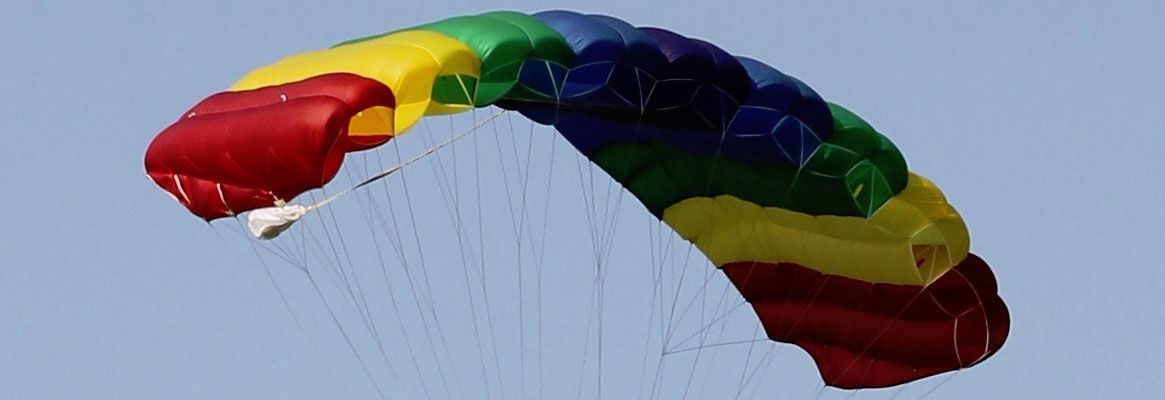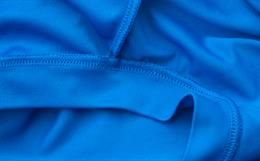ParachuteFabric:
Aparachute is a device, used to slow the motion of an object through anatmosphere by creating drag, or in case of ram-air parachutes, aerodynamiclift. Parachutes are usually made out of light, strong cloth, originally silk,most commonly nylon.
Propertiesof Parachute Fabric:
Inaddition to the structural analysis of the cloth, the properties measured areweight, breaking strength, tear resistance, elasticity, and air permeability.
- Strength:
Clothshould possess a high resistance to the continuation of a tear already started,whereas breaking strength always applies to the simultaneous breaking of systemof yarns.
- Tear Resistance:
Itis the resistance principally of one yarn at a time to a rupture travellingcrosswise from yarn to yarn. In construction of a parachute the gores or panelsare usually cut on the bias, so that the warp and filling yarns make an anglewith the seams running from the centre to the hem of the parachute. In thisway, if tear is started, it follows along the direction of a yarn to the seamwhere the resistance is sufficient to prevent further rupture.
- Elasticity:
Parachute's quick and positive opening, depends largely on the ability of the layers of the cloth to spring apart along the folds, thus permitting air to rush in and quickly inflate the envelope. The elasticity of cloth tends to distribute the sudden load more uniformly over the envelope, thereby preventing development of excessive stress in the region of the envelope.
- Permeability:
Permeability is dependent upon the porosity of the fabric. The porosity is largely determined by the tightness of the fabric weave. Therefore any fabric that has reasonably tight weave is suitable for this perspective.
Raw Materials Used in Parachute Fabric:
Raw materials used in the manufacture of parachutes are Canvas, Silk, Dacron, Kevlar, and Nylon. More specifically parachutes are made up of "Ripstop" nylon that is woven with a double or extra-thick thread at regular intervals, creating a pattern of small squares. This structure keeps small tears from spreading.
One parachute manufacturing plant lists its monthly materials use as exceeding 4,00,000 sq yd (330000 m2) of fabric, 5,00,000 yd (455 km) of tape and webbing, 2.3 million yd (2000 km) of cord, 3,000 lb (1400 kg) of thread.
Advantages of Ripstop Nylon:
- Light weight nylon fabric with interwoven ripstop reinforcement threads in crosshatch pattern.
- Available in different colours and sizes, including thickness.
- Woven with coarse, strong warp and filling yarns at intervals so that tears will not spread.
- Ripstop Nylon are waterproof, water resistant, fire resistant, tear resistant with zero porosity (will not allow water or air through).
- Textures range from a soft and silk-like material to a crisp or stiff fabric.
- Favorable strength-to-weight ratio.
The Manufacturing Process of Parachute Fabric:
Assembling:
- Step 1:
Ripstop nylon cloth is cut according to pattern pieces by a computer-guided mechanism or manually by using a round-bladed electric knife.
- Step 2:
Four trapezoidal panels are sewn together to form a wedge-shaped "gore" about 13 ft (3.96 m) long. A two-needle industrial sewing machine stitches two parallel rows.To provide sufficient strength and enclose the raw fabric edges, a "French fell" seam is used.
- Step 3:
A number of gores (typically 24) are sewn together, side by side, to form a circular canopy. The seams are sewn in the same manner as in Step 2.
- Step 4:
Every panel and every seam is carefully inspected on a inspection table . If any weaving defects, sewn-in pleats, or an incorrect number of stitches per inch is found, the canopy is rejected.
Finishing:
- Step 5:
A tape the same width as the original seam is sewn on top of each radial seam using two more rows of stitching. This tape strengthens the canopy.
- Step 6:
The top of each gore is a few inches (several centimeters) wide; after the gores are sewn together, their tops form a small open circle (the vent) at the center of the canopy. To reinforce the vent and to keep the cloth from fraying, the fabric is rolled around a piece of webbing and sewn with a four-needle sewing machine, which stitches four parallel rows at once.
- Step 7:
The bottom of each gore is 2-3 ft (0.5-1 m) wide. Sewn together, these edges form the outer edge (the skirt) of the canopy. This edge is finished in the same manner as the vent, as in Step 6.
- Step 8:
A short piece of reinforcing tape is sewn to the skirt at each radial tape. It is folded into a "V" pointing outward from the canopy. A specialized automatic sewing machine, designed for this specific operation, is used to sew precisely the same number of stitches in exactly the same pattern every time.
- Step 9:
One end of a 20 ft (6 m) long suspension line is threaded through each V-shaped tab. using a special zigzag pattern that is both strong and elastic; the suspension cord is sewn to the canopy's hem tape and to the canopy seam for a length of 4-10 in (10-25 cm).
- Step 10:
After the 24 suspension lines are sewn to the canopy, 12 1 ft (30 cm) long apex lines are similarly sewn to the central vent. One end of each line is stitched into a V-tab, and then the line crosses the vent to the opposite seam where the other end is stitched into a V-tab.
Rigging:
Later the canopy is attached to the harness by tying the suspension lines to steel connector links on the harness. Attaching the lines to their correct sequential positions on the connecting links of the harness and making certain that the lines are straight is called rigging the parachute.
Image Courtesy:
- Dir.indiamart.com
This article was originally published in Textile learner blog run by Mazharul Islam Kiron.




_Small.jpg)



